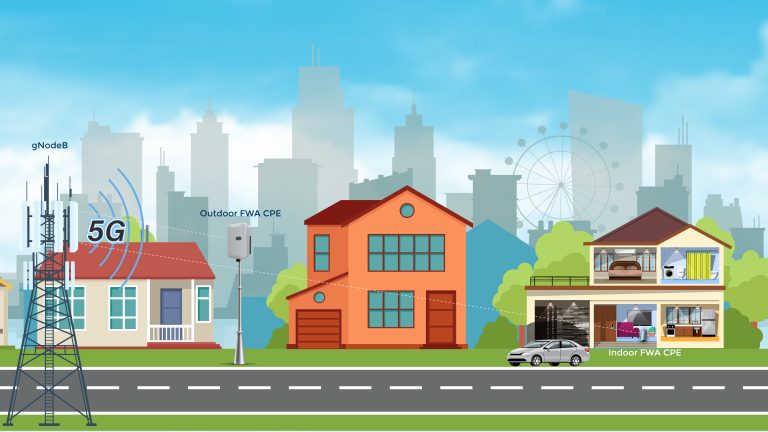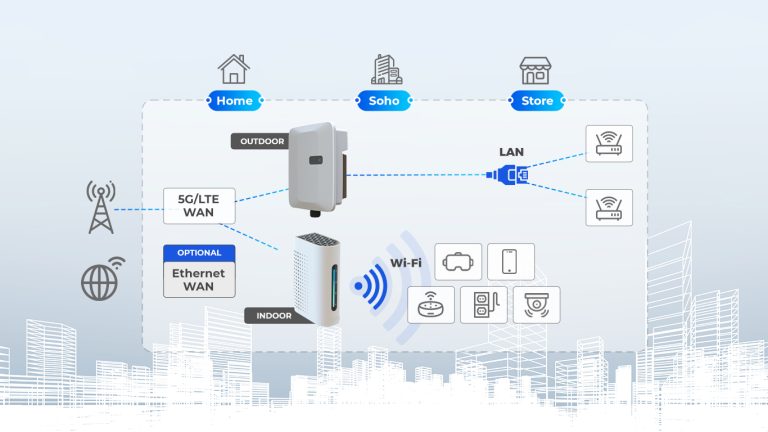Introduction
In the era of 5G, Fixed Wireless Access Customer Premises Equipment (FWA CPE) is transforming how we access and experience high-speed internet. As 5G FWA networks roll out globally, 5G FWA CPE technology emerges as a pivotal component, bridging the gap between robust network capabilities and end-user connectivity demands. This article delves into the intricate workings, technical nuances, and transformative potential of 5G FWA CPE, highlighting its role in ushering in a new era of seamless, ultra-fast internet access.
What is 5G FWA CPE?
5G FWA CPE is a device designed to connect end-users to the 5G network. It is installed at locations such as homes or offices to receive and transmit 5G signals, effectively bridging the gap between the 5G network and the local area network (LAN). This device enables high-speed internet access for various devices, including laptops, smartphones, and IoT devices, providing a versatile and powerful internet solution.
5G FWA CPE can be deployed in both indoor and outdoor scenarios:
- Indoor CPE: Installed inside the premises, it receives 5G signals directly and provides internet access to internal devices.
- Outdoor CPE: Mounted on rooftops or exterior walls, it captures 5G signals from the base station and transmits them via a wired connection (such as Ethernet) to an indoor unit, which then distributes the internet connection to devices within the premises.

Types of 5G FWA CPE
- With Wi-Fi: These devices come with integrated Wi-Fi functionality, allowing them to directly provide wireless internet access to devices within the premises. They convert the 5G signal into a Wi-Fi signal, enabling seamless connectivity for various devices without the need for additional hardware.
- Without Wi-Fi: These devices lack built-in Wi-Fi and instead provide internet access through wired connections. They convert the 5G signal into an Ethernet signal, which can then be distributed via a router or switch to multiple devices within the premises.
How 5G FWA CPE Works
- Signal Reception: The 5G FWA CPE device receives the 5G signal from a nearby 5G base station. These signals are typically in the form of millimeter waves (mmWave) or sub-6 GHz frequencies, depending on the deployment environment and network configuration.
- Signal Conversion: Upon receiving the 5G signal, the CPE device converts it into a Wi-Fi or Ethernet signal. This conversion enables various devices within the premises to connect to the internet. For CPE devices with integrated Wi-Fi, the signal is converted into a Wi-Fi signal, providing wireless connectivity. For those without Wi-Fi, the signal is converted into an Ethernet signal, which is then distributed via wired connections.
- Data Transmission: The CPE device also ensures two-way communication by transmitting data back to the 5G base station. This continuous exchange of data between the CPE device and the base station ensures a reliable and high-speed internet connection for end-users.
Key Components of 5G FWA CPE
5G FWA CPE consists of several critical components that work together to provide high-speed internet connectivity. These components ensure efficient signal reception, conversion, and distribution within the premises. Here is an in-depth look at the key components of 5G FWA CPE:
- Antenna: Captures 5G signals from the nearby base station. Modern CPEs utilize multiple-input multiple-output (MIMO) technology, which employs multiple antennas to enhance signal reception and transmission. MIMO improves data throughput and reliability by allowing multiple data streams to be transmitted and received simultaneously.
- Outdoor Antenna: Typically mounted on rooftops or exterior walls for optimal signal reception, especially in areas with weak indoor penetration.
- Indoor Antenna: Integrated within the CPE device for convenient installation and use inside the premises.
- Modem: Converts the captured 5G signals into usable data for connected devices. The modem handles the demodulation and modulation of 5G signals, converting radio frequency (RF) signals into digital data and vice versa. It supports various 5G frequency bands, including sub-6 GHz and millimeter wave (mmWave), ensuring compatibility with different network deployments.
- Router: Distributes the internet connection to multiple devices within the premises. The router can provide both wireless (Wi-Fi) and wired (Ethernet) connectivity.
- Wi-Fi Router: Converts the 5G signal into a Wi-Fi signal, creating a wireless local area network (WLAN) that multiple devices can connect to. Modern CPEs support advanced Wi-Fi standards such as Wi-Fi 7 (802.11be) and Wi-Fi 6 (802.11ax), offering higher data rates, increased capacity, and improved performance in dense environments.
- Ethernet Router: Provides wired connections via Ethernet ports, ensuring stable and high-speed internet access for devices requiring a more reliable connection, such as desktop computers and smart TVs.
- Power Supply: Ensures the CPE device remains operational.
- Direct Power Supply: Utilizes a direct connection to the electrical grid via an AC adapter.
- Power over Ethernet (PoE): Some CPE devices support PoE, which allows both power and data to be delivered over a single Ethernet cable. This simplifies installation and reduces the need for additional power outlets.
- Firmware and Software: Provides the necessary instructions and user interface for the CPE device.
- Network Management: Tools for monitoring and managing network performance, including diagnostics and troubleshooting.
- Security: Implements robust security protocols such as WPA3 for Wi-Fi, firewall protection, and VPN support to safeguard the network against unauthorized access and cyber threats.
- Updates: Regular firmware updates ensure the device remains secure and up-to-date with the latest features and improvements.
Benefits of 5G FWA CPE
- High-Speed Internet: 5G CPE can provide gigabit-speed internet, much faster than traditional broadband connections.
- Low Latency: Essential for real-time applications like online AR/VR applications, gaming, video conferencing, and remote surgery.
- Easy Installation: Plug-and-play devices that do not require complex setup or wiring.
- Enhanced Connectivity: Supports multiple devices simultaneously, making it ideal for smart homes and offices.
Technical Specifications of 5G FWA CPE
- Frequency Bands: Operates in both sub-6 GHz and mmWave frequency bands.
- MIMO Technology: Utilizes advanced MIMO technology for better signal strength and coverage.
- Wi-Fi Standards: Compatible with Wi-Fi 7 (802.11be) and Wi-Fi 6 (802.11ax) for faster wireless speeds and improved network efficiency.
- Security: Equipped with advanced security features like WPA3, VPN support, and firewall protection.
- TR Protocols: Supports TR-069 & TR-181 for remote management and configuration, TR-143 for network performance measurement, and TR-369 (USP) for enhanced device and service management.
- Ethernet Ports: Includes multiple Gigabit Ethernet ports for high-speed wired connections.
- Processor: Powered by a multi-core processor to handle complex tasks and ensure smooth performance.
Applications of 5G FWA CPE
- Home Broadband: Replacing traditional DSL, cable, and fiber connections with faster and more reliable 5G internet.
- Enterprise Solutions: Providing high-speed internet for businesses, enabling cloud computing, video conferencing, and IoT applications.
- Remote Areas: Offering broadband solutions in rural or underserved areas where laying fiber-optic cables is impractical.
- Mobile and Temporary Sites: Ideal for events, construction sites, and other temporary locations that require quick internet setup.

VVDN’s 5G FWA CPE Capabilities with an Agile & Flexible Approach
With more than 17 years of experience in the industry, VVDN is a trusted partner for leading OEMs and Telcos across the globe. Here’s why:
- Software & Hardware Design Expertise: VVDN has its own software stack for 5G FWA CPE with TR standards and a team of experts who specialize in end-to-end software and hardware design. From conceptualization to prototyping and mass production, we support you at every stage of the design process.
- RF and Antenna Design Expertise: Our RF engineering team excels in transmission systems, RF tuning, calibration, and circuit evaluation for 5G FWA CPEs. We have best-in-class RF antennas, including outdoor antenna design expertise, to help you optimize your device’s performance and ensure reliable connectivity.
- Multiplatform Versatility: VVDN has diverse capabilities across multiple chipset platforms. This allows us to harness the latest technology and expertise, accelerating the development of advanced products for OEMs and Telcos in the networking and wireless domain.
- In-house Testing Labs: We have in-house testing labs equipped with advanced testing equipment and instruments. This allows us to ensure that your 5G FWA CPEs meet the highest quality standards and perform as expected.
- Mechanical Expertise: Our mechanical design team provides robust solutions for 5G FWA CPE enclosures, ensuring durability and efficiency in both indoor and outdoor environments.
- Meeting End-to-End Requirements of 5G FWA CPE: When it comes to designing and manufacturing a 5G FWA CPE, VVDN has capabilities in product engineering and manufacturing, helping global Telcos and OEMs with cutting-edge networking and Wi-Fi solutions. Our agile and flexible approach ensures that we can meet the unique requirements of each project
VVDN has a 5G FWA CPE reference design that is available for white-labeling to help OEMs with faster time to market. Write to us at info@vvdntech.com to know more.
























